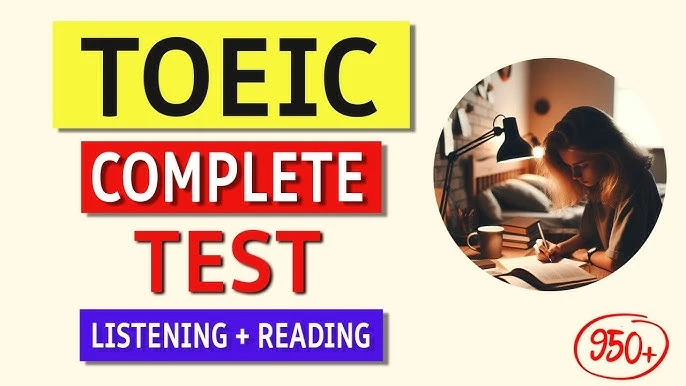
English vocabulary and phrases on Mid-Autumn Festival
The TOEIC (Test of English for International Communication) exam with 200 questions is still one of the most popular and prestigious business English proficiency tests in the world as well as in Vietnam. To achieve the target score, learners need a systematic, comprehensive and scientific review strategy. This article will provide a detailed roadmap, from the test structure, effective test-taking methods for each section, to a study plan and quality reference materials.










The traditional TOEIC test has two main sections: Listening Comprehension and Reading Comprehension, with a total duration of 120 minutes (2 hours).
Part I: Listening Comprehension (45 minutes, 100 questions)
Part 1: Picture Description (6 questions): You'll see a picture and hear four short statements (A, B, C, D). Your task is to choose the statement that best describes the picture.
Part 2: Question & Response (25 questions): You'll hear a question or a statement followed by three responses (A, B, C). You must choose the most appropriate response.
Part 3: Short Conversations (39 questions - 13 conversations, 3 questions each): You'll listen to short conversations between two or three people. After each conversation, there are three questions, each with four options (A, B, C, D).
Part 4: Short Talks (30 questions - 10 talks, 3 questions each): You'll hear short talks like announcements, advertisements, excerpts from speeches, or voicemail messages. After each talk, there are three questions, each with four options (A, B, C, D).
Part II: Reading Comprehension (75 minutes, 100 questions)
Part 5: Incomplete Sentences (30 questions): Each sentence has a blank and four options (A, B, C, D) to fill it in. This section tests your knowledge of grammar and vocabulary.
Part 6: Text Completion (16 questions - 4 passages, 4 questions each): You will read short passages with blanks. You must choose the most suitable word, phrase, or sometimes a full sentence to fill the blank and complete the context.
Part 7: Reading Comprehension (54 questions): This section includes both single and multiple passages from various text types like emails, notices, advertisements, articles, charts, and more.
Single Passages: Around 10 passages, with 2-4 questions per passage.
Multiple Passages: Sets of two or three related passages, with 5 questions per set.

Overall Tip: Maintaining high concentration is crucial as the audio is played only once.
Part 1 - Picture Description:
Before listening: Quickly observe the picture, identifying the main subject, actions, and setting (indoors, outdoors, office, etc.).
While listening: Listen and eliminate incorrect options. Be careful with homophones or similar-sounding words that have different meanings. Choose the statement that provides the most accurate and comprehensive description.
Part 2 - Question & Response:
Focus on the Wh-words: Pay close attention to words like What, When, Where, Who, Why, and How. The response should correspond directly to the question word.
Be aware of Yes/No questions and tag questions.
Note: The answer doesn't have to be a complete sentence; it could be a phrase or an indirect response.
Part 3 & 4 - Conversations and Short Talks:
Read the questions first: Use the time between sections to quickly read the questions and answer choices. This helps you anticipate the information you need to listen for.
Identify key information: In Part 3, determine who is speaking and their relationship. In Part 4, identify the type of talk (announcement, advertisement, etc.) and the intended audience.
Answer based on what you hear, not on assumptions. Questions are often in the same order as the information appears in the audio.
Overall Tip: Time management is a critical skill. With 75 minutes for 100 questions, you have an average of only 45 seconds per question.
Part 5 - Incomplete Sentences:
Classify the question: Determine if it's a grammar question (tenses, word forms, prepositions, conjunctions) or a vocabulary question.
Solve quickly: Grammar questions can often be solved fast if you know the rules. For vocabulary questions, if you don't know the meaning, use the context or eliminate incorrect options.
Time goal: Aim to complete this part in about 10-15 minutes.
Part 6 - Text Completion:
Read the whole passage: Don't just read the sentence with the blank. Read the sentences before and after to understand the context.
Pay attention to the questions that require filling in a complete sentence: You need to understand the meaning of the entire passage to choose the most logically and semantically fitting sentence.
Time goal: Aim to complete this part in about 8-10 minutes.
Part 7 - Reading Comprehension:
Read the questions first: Read the questions to identify keywords you need to find. Then, scan the passage to locate the relevant information.
Use skimming and scanning skills: Use skimming to get the main idea of the passage and scanning to find specific details.
Allocate your time wisely: Spend more time on the multiple-passage sets as they are more complex.
Time goal: Aim to complete this part in about 50-55 minutes.

Phase 1: Build Your Foundation (1-2 months):
Grammar: Review key TOEIC grammar topics (tenses, passive voice, relative clauses, comparisons, word forms, prepositions, conjunctions).
Vocabulary: Learn vocabulary based on common business and daily life topics (office, business, finance, travel, shopping, etc.).
Phase 2: Targeted Practice (2-3 months):
Focus on solving practice questions part-by-part (e.g., Part 1, Part 2, etc.) to get familiar with the question types and improve your skills.
Analyze your mistakes: Keep a record and analyze the questions you get wrong to understand your weaknesses and learn from them.
Phase 3: Full-Length Practice and Time Management (1 month before the test):
Practice full 200-question TOEIC tests under timed conditions (120 minutes).
Use a timer strictly to practice managing your time.
Your goal is to complete the test with a little time left over to review your answers.

Books:
ETS TOEIC Test Official Test-Preparation Guide: The official series from the test creator. The practice tests are the most accurate in terms of difficulty and structure.
Economy TOEIC (Vol 1-5): A classic practice test series suitable for intensive practice.
Hacker TOEIC: Provides detailed strategies and tips for each part of the test.
600 Essential Words for the TOEIC: A foundational vocabulary book.
Websites and Apps:
Various online platforms offer free, timed practice tests.
Vocabulary apps like Anki or Quizlet are great for learning and reviewing new words effectively.
Succeeding in the 200-question TOEIC test requires persistence, effort, and a smart study approach. By mastering the test structure, applying effective strategies, and following a systematic study plan, you can absolutely achieve your desired TOEIC score. Good luck!

English vocabulary and phrases on Mid-Autumn Festival

Tips to improve vocabulary in communication

English vocabulary by topic: Clothes

The secret to remembering all 50 English vocabulary words every day easily

English vocabulary by topic: Human body

Vocabulary of the most popular subjects in English

Learn English about Covid: All about vocabulary and disease prevention

Vocabulary of Subjects in English

Set of 60 English vocabulary on educational topics

Vocabulary - just a small thing!
Comment ()